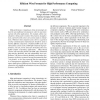Free Online Productivity Tools
i2Speak
i2Symbol
i2OCR
iTex2Img
iWeb2Print
iWeb2Shot
i2Type
iPdf2Split
iPdf2Merge
i2Bopomofo
i2Arabic
i2Style
i2Image
i2PDF
iLatex2Rtf
Sci2ools
SC
2000
ACM
2000
ACM
Efficient Wire Formats for High Performance Computing
High performance computing is being increasingly utilized in non-traditional circumstances where it must interoperate with other applications. For example, online visualization is being used to monitor the progress of applications, and real-world sensors are used as inputs to simulations. Whenever these situations arise, there is a question of what communications infrastructure should be used to link the different components. Traditional HPC-style communications systems such as MPI offer relatively high performance, but are poorly suited for developing these less tightly-coupled cooperating applications. Object-based systems and meta-data formats like XML offer substantial plug-and-play flexibility, but with substantially lower performance. We observe that the flexibility and baseline performance of all these systems is strongly determined by their `wire format', or how they represent data for transmission in a heterogeneous environment. We examine the performance implications of...
Applied Computing | SC 2000 | Substantial Plug-and-play Flexibility | Tightly-coupled Cooperating Applications | Wire Formats |
| Added | 25 Aug 2010 |
| Updated | 25 Aug 2010 |
| Type | Conference |
| Year | 2000 |
| Where | SC |
| Authors | Fabián E. Bustamante, Greg Eisenhauer, Karsten Schwan, Patrick Widener |
Comments (0)

